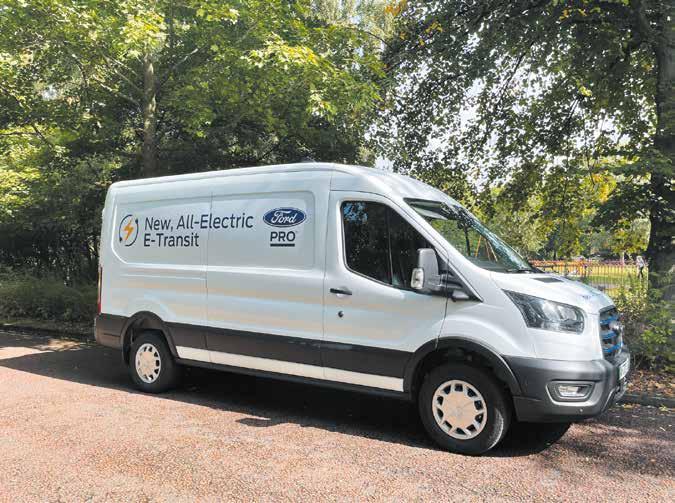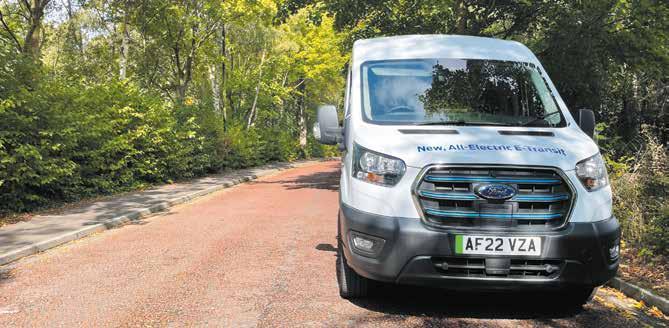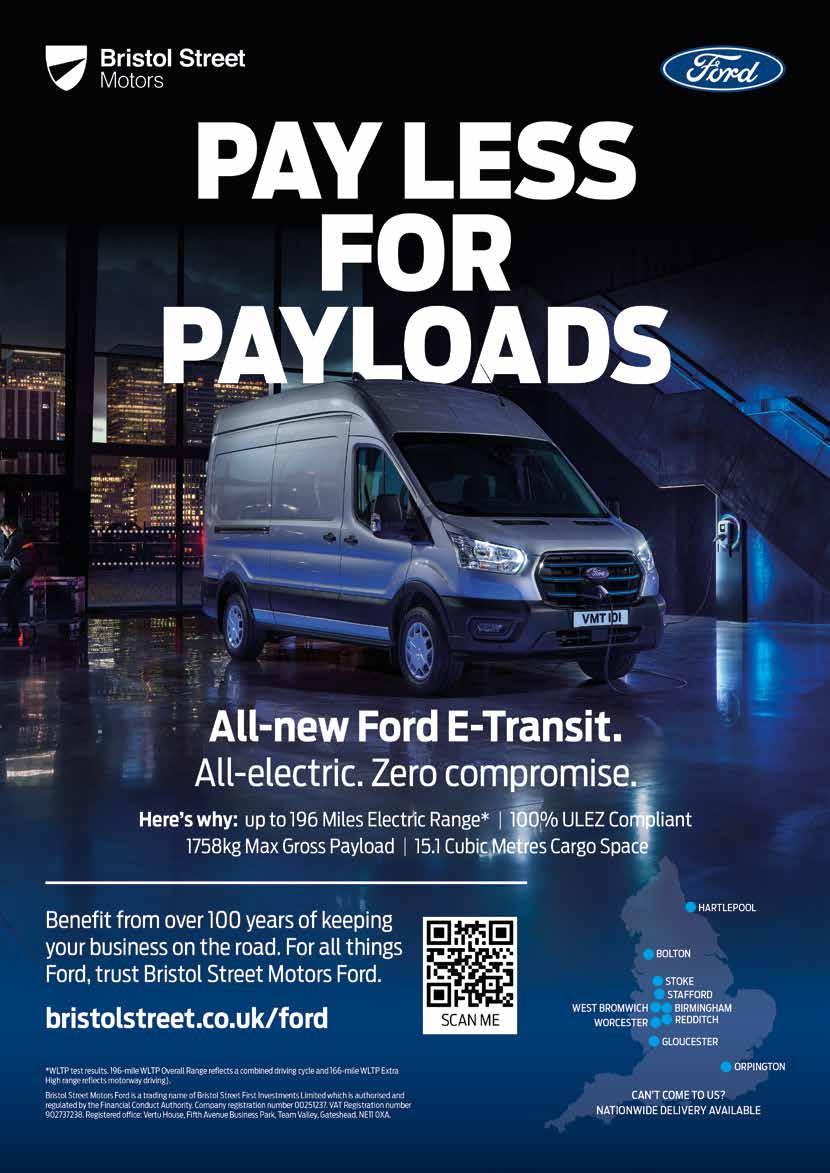
7 minute read
Ford E-Transit
You can criticise Ford for being late to the party with an electric version of the Transit... but you can’t criticise the van itself, says Andrew Walker
Ah Mr Ford, we’ve been expecting you...
Advertisement
While Ford has been late to the electric van party with a version of its best-selling Transit, the first E-Transit is finally with us and it promises to be a game changer.
With prices starting at £48,045 plus VAT, it’s off to a good start, undercutting a number of competitors’ electric vans from the get-go.
It’s based on the Transit diesel so instead of an engine, gearbox and transmission you get electric running gear sourced from the Ford Mustang Mach-E. This is connected to a 68kWh battery and comes with two power outputs, 181bhp or 265bhp.
It still looks like a standard Ford Transit however, with the bonnet now home to various electrics.
Versions
One of the reasons Ford is so popular is because it has always offered a wide range of model options, and the same is true for E-Transit.
There are 25 versions to choose from, in three lengths, two heights and three weights, and you can also have it as a panel van, a chassis cab and a double-cab.
There are actually five sizes of E-Transit panel van: L2 length in H2 or H3 heights; an L3 length in H2 or H3; and an L4, which is only available with the H3 height.
For spec your choice is Leader or Trend, both offering slightly better spec than the equivalent diesel Transit.
Outside
As we said, it looks like a standard Transit. However, move closer and you’ll notice the blue striped front grille behind which sits the charging socket, conveniently located dead centre. There’s also an E-Transit logo on the rear doors, but that’s about it.
Or is it? What you can’t see is what’s going on underneath the van. The electric motor is mounted under the rear of the van, so the rear suspension is independent, the result being an impeccable ride.
Inside
What really lifts the new Ford above other large electric vans is the cabin. It’s beautifully put together and features good quality plastics on all surfaces. It’s finished in a colour combo of grey and black that looks and feels durable.
Our test van featured Ford’s excellent 12” touchscreen which uses the latest SYNC4 system. There’s no gear lever, of course, rather a circular gear changer with, from left to right, P, R, N and D, with the addition of L in the centre which enables regeneration of the battery.
Charging and range
Here’s the key bit: charging and range. The E-Transit has a claimed maximum range of 196 miles. As a caveat, Ford realises that in winter and when fully loaded, the electric range will be lower, and so has spent lots of time and money ensuring that even if driven in the coldest, harshest weather, your E-Transit is good for a minimum of 100 miles. This may not sound great, but that 100 miles is still more than the eSprinter offers when fully charged.
Charging at home on an 11kWh charger means a 0-100% full time of 11.5 hours. Because the E-Transit has an option for 115kW fast charging, the 68kWh battery pack can be charged to 80% in just 35 minutes.
Remember: Get a home smart charger and an electric vehicle electricity deal. You can then plug-in at night from as little as 7.5p a kWh.
Standard equipment
The E-Transit comes in two trim levels: Leader and Trend. Both have slightly more standard equipment than the equivalent diesel models. So, Leader gets semi-automatic air conditioning, a heated windscreen, an electric parking brake, keyless start, a metal bulkhead, 12” infotainment display with Ford Sync 4, DAB radio, Android Auto and Apple CarPlay. Safety come in the form of ESC and side-wind assist.
Move up to Trend and you’ll add SatNav, cruise control, front and rear parking sensors and a moulded floor liner. Extra safety features included on Trend, are Lane Departure Warning, Collision Mitigation and a Lane Keeping aid. Our test van also featured a permanent rear view camera, an optional extra. It’s a brilliant addition and super clear.
Continued on page 50

The 184bhp E-Transit’s automatic box takes the stress out of stop-start traffic... you’ll not want to go back to a manual ‘‘

Continued from page 48 Practicality
Maximum capacity is 15.1 cubic metres, while maximum payload is 1748kg. The rear load space is easily accessed via twin rear doors and a near side sliding door. The interior is plywood panelled with four internal roof lights and a number of load hooks.
The cabin offers plenty of storage solutions. The highlight is a pop-out drinks holder while you also get two dash-top spaces, a closed glove box, a dash front open storage area, two large door pockets and an overhead storage shelf. There is a 12V cabin socket and a USB connection.
Drivers get a multi-adjustable seat and a reach and rake adjustable steering wheel, so tailoring a comfortable driving position is easy.
Ford E-Transit warranty
E-Transits are covered by the same three-year warranty as any other Transit. The electric drive components get a longer eight-year / 100,000 mile warranty.
Driving
A short hop around the M60 and some real world driving in south Manchester gave us a really good idea of how the E-Transit feels. Quiet, smooth, comfortable all spring to mind, but our overwhelming feeling was of calm. It’s a large van but in electric format it’s so easy to drive. The seats are comfortable and just the right height. The interior is really user-friendly.
For example, I connected my iPhone wirelessly to Apple CarPlay in seconds. Even the climate controls, which are worked via the touchscreen, are really simple to use and more importantly, easy to reach from the driver’s seat.
Performance is there if required, but the E-Transit doesn’t shoot away when you accelerate. Rather, the power is delivered smoothly. The cabin is super-quiet with just some tyre noise disturbing your peace and quiet.
We drove the likely best-selling 184bhp version of the E-Transit. Being automatic, it takes the stress out of stop-start traffic and once experienced, you’ll not want to go back to a manual. Furthermore, the re-engineered rear axle set-up featuring coil springs when combined with the centrally located battery, offers a less bumpy ride when your Transit is unladen than you get in a diesel van.
The other benefit the battery gives is the E-Transit feels better planted on the road than a
diesel van, whether you’re driving in straight line or entering or exiting corners.
Instrumentation
The E-Transit’s instrument cluster is markedly different to that of a standard Transit. It includes a power-use indicator, which also lets you know when battery recuperation is taking place, and the fuel gauge, which shows your battery range. After a half hour or so behind the wheel you soon get used to the different functions compared to those in a standard diesel van.
Energy recuperation
Regarding energy recuperation, the E-Transit offers two ways to re-charge the batteries. Tap the brake pedal and you’ll activate the first regen mode. Tap it twice and you default to the more pronounced L setting. If you then accelerate, the van returns to the standard Drive setting. You can also select L which is located in the middle of the gear buttons.
The regeneration in the E-Transit is quite light underfoot and not really that noticeable.
Pros
Competitively priced, with a myriad of sizes and versions offered. E-Transit also comes with excellent storage and payload capacity. You also get a car-like user-friendly cabin which also features lots of storage solutions. Easy and relaxing to drive, with a class-leading range.
Cons
It may be attractively priced versus other large electric vans, but at the best part of £50,000 it’s expensive when compared to a diesel Transit. Not really a van for towing.
The mileage range is impressive, but it’s still less than half of what a diesel Transit offers.
Conclusion
Whoever laughs last, laughs longest and Ford has certainly laughed last here. While a long time in the making, the E-Transit bursts on to the scene and puts itself right at the top of the best electric vans money can buy.
Of its competitors, only the Maxus eDeliver 9 can match its range, while the Fiat Professional eDucato has it beaten for maximum payload.
In addition, the launch of Ford Pro will allow new electric customers to transition to an EV with much less fuss than they’d be expecting, which is another big tick.
ABOUT... FORD PRO Ford devoted a large chunk of its CV Show stand in 2022 to Ford Pro. This offers a full range of support for its vans, including servicing, finance, telematics and charging infrastructure, adding peace of mind to businesses taking their first plunge into electric vans.
• Our thanks to Evans Halshaw Transit Centre Manchester for the loan of the E-Transit
CC&V VERDICT
Currently the best all-around large electric van on the market












